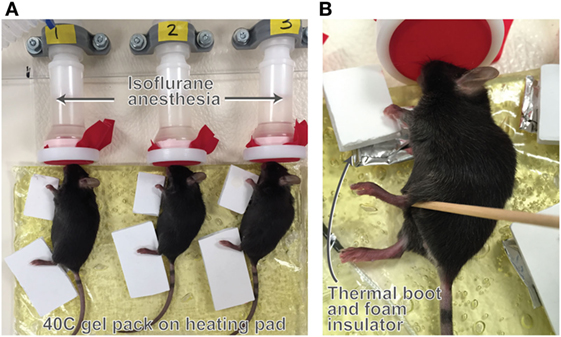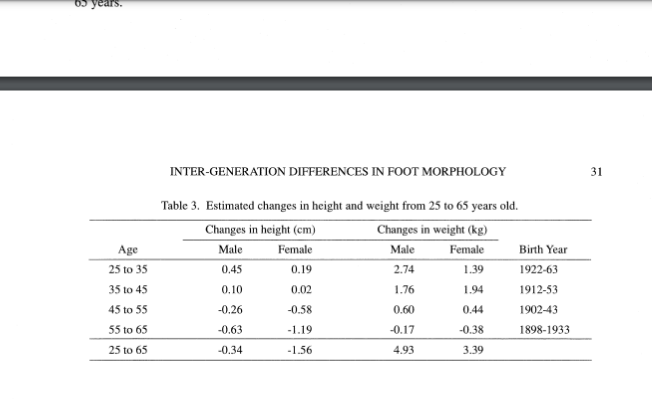I’ve written about heat being used to grow taller before. Heat also increases the rate at which chemical reactions occur which could be part of it. Here’s more on heat to grow taller. Heat could potentially increase solute uptake of the growth plate cartilage. Such things wouldn’t be really helpful to those who are skeletally mature although there is the possibility that heat could provide some kind of stimulus to the bone in which case it would help skeletally mature individuals.
Heat-Induced Limb Length Asymmetry Has Functional Impact on Weight Bearing in Mouse Hindlimbs
“As a noninvasive alternative, we previously developed a once daily limb-heating model using targeted heat on one side of the body for 2 weeks to unilaterally increase bone length by up to 1.5% in growing mice. In this study, we applied heat for 1 week to determine whether these small differences in limb length are functionally significant, assessed by changes in hindlimb weight bearing. We tested the hypothesis that heat-induced limb length asymmetry has a functional impact on weight bearing in mouse hindlimbs. Female 3-week-old C57BL/6 mice (N = 12 total) were treated with targeted intermittent heat for 7 days (40 C for 40 min/day){most humans have intermittent heat exposure though}. High-resolution x-ray (N = 6) and hindlimb weight bearing data (N = 8) were acquired at the start and end of the experiments. There were no significant left-right differences in starting tibial length or hindlimb weight bearing. After 1-week heat exposure, tibiae and femora were ~1 and 1.4% longer, respectively, on the heat-treated sides (40 C) compared to the non-treated contralateral sides (30 C). Tibial elongation rate was over 6% greater. “
“warm-reared mice had consistently longer ears, limbs, and tails when compared to littermates raised at cooler temperatures”<-studies have found however that humans raised at cooler environments tend to be taller. This finding though also means that it’s possibly that not only is growth rate increased but also height at skeletal maturity.
Here’s the heating device:

“heat-induced limb length differences do persist at skeletal maturity in 12-week-old mice that were examined 7 weeks after a juvenile heat-treatment”
” heat-based methods for treating minor limb length discrepancies may ultimately provide alternatives to traditional surgical approaches that can be painful and invasive.”<-so they do think that the method could be applied to humans.
“The increase in bone elongation rate generated by localized heat could help equalize minor limb length and weight bearing asymmetry in children”<-although we’d want something that works in older individuals.
There was a follow up paper:
Heat-Induced Limb Length Asymmetry Has Functional Impact on Weight Bearing in Mouse Hindlimbs
“Limb length inequality results from many types of musculoskeletal disorders. Asymmetric weight bearing from a limb length discrepancy of less than 2% can have debilitating consequences such as back problems and early-onset osteoarthritis. Existing treatments include invasive surgeries and/or drug regimens that are often only partially effective. As a noninvasive alternative, we previously developed a once daily limb-heating model using targeted heat on one side of the body for 2 weeks to unilaterally increase bone length by up to 1.5% in growing mice{1.5% is huge. That’s the difference between 5’9″ and 5’10”}. In this study, we applied heat for 1 week to determine whether these small differences in limb length are functionally significant, assessed by changes in hindlimb weight bearing. We tested the hypothesis that heat-induced limb length asymmetry has a functional impact on weight bearing in mouse hindlimbs. Female 3-week-old C57BL/6 mice (N = 12 total) were treated with targeted intermittent heat for 7 days (40 C for 40 min/day). High-resolution x-ray (N = 6) and hindlimb weight bearing data (N = 8) were acquired at the start and end of the experiments. There were no significant left-right differences in starting tibial length or hindlimb weight bearing. After 1-week heat exposure, tibiae (t = 7.7, p < 0.001) and femora (t = 11.5, p < 0.001) were ~1 and 1.4% longer, respectively, on the heat-treated sides (40 C) compared to the non-treated contralateral sides (30 C). Tibial elongation rate was over 6% greater (t = 5.19, p < 0.001). Hindlimb weight bearing was nearly 20% greater (t = 11.9, p < 0.001) and significantly correlated with the increase in tibial elongation rate on the heat-treated side (R2 = 0.82, p < 0.01). These results support the hypothesis that even a small limb length discrepancy can cause imbalanced weight distribution in healthy mice. The increase in bone elongation rate generated by localized heat could be a way to equalize limb length and weight bearing asymmetry caused by disease or trauma, leading to new approaches with better outcomes by using heat to lengthen limbs and reduce costly side effects of more invasive interventions.”
“warm-reared mice had consistently longer ears, limbs, and tails when compared to littermates raised at cooler temperatures”
Here is the skeletal effects:

This next paper is a review paper that covers everything more thoroughly:
Temperature, heat shock proteins and growth regulation of the bone tissue
“Ambient heat modulates the elongation of bones in mammals, and the mechanism of such a plasticity has not been studied completely. The influence of heat on growth and development of bone depends on its values. Five zones of temperature influence on the bone tissue with different biological effects have been distinguished : a) under-threshold thermal zone < 36.6 ºС, insufficient amount of heat is a limiting factor for osteogenesis; b) normal temperature zone 36.6‒37.5 ºС, the processes of breakdown and development of bone in this temperature range is balanced; b) zone of mild thermal shock 39‒41 ºС, the processes of functioning of osteoblasts, osteocytes and formation of the bone tissue intensify; d) the zone of sublethal thermal shock > 42 ºС, growth of bone slows; e) zone of non-critical shock > 50 ºС, bone tissue cells die.{so seems like heat as a stimulus is biphasic where there’s an optimal zone, but heat can be combined with other stimuli}. We propose a model of the mechanism of influence of heat shock on bone growth. Mild heat shock is a type of stress to which membrane enzymes adenylyl cyclase and cAMP-protein kinase react. Protein kinase A phosphorylates the gene factors of thermal shock proteins, stress proteins and enzymes of energy-generating processes – glycolysis and lipolysis. Heat shock protein HSP70 activates alkaline phosphatase and promotes the process of mineralization of the bone tissue. In the cells, there is intensification in syntheses of insulin-like growth factor-I, factors of mitogenic action, signals of intensification of blood circulation (NO) and synthesis of somatotropin. The affinity between insulin-like growth factor I and its acid-labile subunit decreases, leading to increased free and active insulin-like growth factor I. Against the background of acceleration of the capillarization process, energy generation and the level of stimulators of growth of bone tissue, mitotic and functional activities of producer cells of the bone – osteoblasts and osteocytes – activate{would be interesting to see how osteoclasts are affected as they alter growth}. The generally known Allen’s rule has been developed and expanded: “Warm-blooded animals of different species have longer distal body parts (tails) if after birth the young have developed in the conditions of higher temperature”. The indicated tendency is realized through increased biosynthesis of heat shock proteins and other stimulators of growth processes in the bone tissue.”
“In one experiment, two month-old male mice C57BL/6J were exposed to cold (4 °C) and normal (23 °C) temperatures for 28 days. Cold increased the apoptosis of osteocytes and decreased the length of the canals. Those changes were accompanied by decrease in the number of osteocytes that were positive to Е11 (transmembrane glycoprotein, important for differentiation of osteocytes, first of all prolonging dendrites) and ММР13 (matrix metallopeptidase that breaks down the collagen I in extracellular matrix and potentially plays a role in rotating the articular cartilage) after 14 days. The indicated parameters returned to the initial levels after 28 days. The study revealed that after 14 days of influence of
low temperatures the volumetric bone fraction significantly decreased, but recovered after 28 days. Brown adipose tissue affected remodeling of the bone by increasing thermogenesis”
“Mild thermal stress increases the processes of regeneration of blood vessels and bones”
“A study reported that heat stress effectively induced the development of new bone tissue in an experimental model with 58 rats and 10 rabbits. The experimental animals underwent hyperthermia in 45 °С for 15 min once and three times a week, the changes in their bone tissue being determined by x-ray and histological evaluation. After the procedure of thermotherapy (1 time/week over 4 weeks), the experimental groups of rats and rabbits were observed to have a heightened level of osteogenesis compared with the control. The researchers inferred that thermal stimuli with heated materials enhance osteogenesis and increase the area of the development of bones and would be useful in treatment of bone defects in cases of skeletal diseases”<-this could potentially impact height.
Note that just because the muscles are stimulated by exercise to increase temperature does not mean bones do in the same way.
“Heat influence induces HSP expression. They stabilize proteins that strengthen the transmission of the signals of nitrogen oxide (NO), decrease oxidative stress and inflammation of the vessels and improve their function. During passive heat stress, blood circulation in the legs increased ~ 3–4-fold”
“The cartilage has no blood vessels and its nutrition is performed by diffusion of substances. The semi-penetrable “barrier at the border of vessel-cartilage surface” obstructs the molecular transport. To study the peculiarities of overcoming this obstacle, a model of heating the hind legs was used for manipulating the blood circulation in bones in 5-week-old female mice. In the experiment, dextrans were used weighing 10, 40 and 70 kDa, which are close in size to physiological regulators. Increase in the temperature in hind legs from 22 to 34 °C led to increase in vascular access of the abovementioned molecules. In 34 °C, penetration of dextrans 10 kDa into the growth plate increased by > 150%, and 40 and 70 kDa increased only by < 50%“<-so temperature managed to increase nutrient delivery into the growth plate by a significant amount.
“at HSP70 (200 ng/mL) increases the activity of alkaline phosphatase and promotes the mineralization of the bone tissue. In the conditions of osteogenic induction, this heat shock protein increased the expression of osteospecific genes such as transcriptional factors of family runt Runx2 and osterix (OSX). HSP70 promotes osteogenesis and may be a therapeutic mean for treating uncoalesced bones”
“Osteochondral interface between the bone and the cartilage allows these tissues to “communicate” with one another and exchange signal and plastic molecules, thereby providing integrated response to mechanical and thermal irritators”


